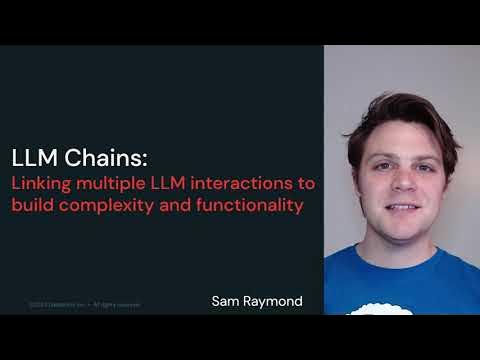LLM Module 3 - Multi-stage Reasoning | 3.6 Summary
Summary
TLDRIn this module, we explored multi-stage reasoning with LangChain and LLM agents, showcasing how LLM chains help structure workflows by combining prompt templates with task-specific models to produce desired outcomes. We examined how LangChain provides a framework for easier tool integration, allowing LLMs to tackle diverse tasks beyond natural language processing, including code compilation and complex logic execution. Additionally, we discovered the incredible potential of LLM agents in performing groundbreaking tasks. Now, it’s time to dive into the notebooks to see these concepts in action.
Takeaways
- 😀 LangChain enables multi-stage reasoning by combining LLM chains with prompt templates and task-specific LLMs to produce results step by step.
- 😀 LLM chains help in building structured workflows, which allow for better organization and task management when using LLMs.
- 😀 LangChain provides a wrapper around these chains, making it easier to leverage different tools and architectures for complex tasks.
- 😀 With LangChain, it's possible to combine natural language processing with other complex functions, such as compiling code and running logic.
- 😀 LLM agents can be used to perform a wide range of tasks, showcasing potential beyond what we've fully explored so far.
- 😀 LangChain offers flexibility in integrating different tools and capabilities, giving users the ability to tackle varied tasks.
- 😀 The power of LangChain lies in its ability to structure and automate workflows, enhancing the efficiency of using LLMs for multiple tasks.
- 😀 The module explored the combination of different technologies to allow LLMs to perform beyond their traditional capabilities.
- 😀 LLM agents are still evolving, with their full potential yet to be realized, and the module introduces just a glimpse of that potential.
- 😀 The transition to hands-on practice in notebooks will allow users to apply the concepts discussed and see LangChain in action.
Q & A
What is the focus of the third module in this course?
-The third module focuses on multi-stage reasoning with LangChain and LLM agents. It explores how to combine LLM chains with task-specific prompts to build structured workflows.
How do LLM chains contribute to the workflow in LangChain?
-LLM chains help in structuring the workflow by combining prompt templates with task-specific LLMs, allowing for the step-by-step production of desired results.
What is the role of LangChain in building and leveraging different tools?
-LangChain provides a wrapper around chains, making it easier to leverage different tools and architectures to enable LLMs to perform a variety of tasks beyond natural language processing, such as compiling code and running complex logic.
What are some examples of tasks that LLMs can perform with LangChain?
-With LangChain, LLMs can perform tasks such as natural language processing, compiling code, and executing various types of complex logic.
What is the significance of LLM agents in the context of LangChain?
-LLM agents are capable of performing advanced and impressive tasks that showcase the potential of LangChain, although the full extent of their abilities is yet to be fully realized.
Why is the potential of LLM agents considered exciting?
-The potential of LLM agents is exciting because they are able to execute complex tasks that go beyond simple language processing, and their capabilities are still evolving.
What did the speaker suggest about the use of LangChain tools?
-The speaker suggests that LangChain tools can be utilized to facilitate various types of tasks, enabling users to easily integrate and manipulate different components in a structured manner.
What is the intended takeaway from this module?
-The intended takeaway from this module is to demonstrate how LangChain and LLM agents can be used to build powerful workflows and perform a range of sophisticated tasks that leverage different tools and architectures.
What can learners expect to see in the notebooks following this module?
-Learners are encouraged to explore the notebooks, where they will see practical examples of LangChain and LLM agents in action, showcasing how these concepts work in real scenarios.
What is the main advantage of using LangChain for multi-stage reasoning?
-The main advantage of using LangChain for multi-stage reasoning is its ability to combine multiple tools and models into a seamless workflow that can handle complex tasks with precision and flexibility.
Outlines

This section is available to paid users only. Please upgrade to access this part.
Upgrade NowMindmap

This section is available to paid users only. Please upgrade to access this part.
Upgrade NowKeywords

This section is available to paid users only. Please upgrade to access this part.
Upgrade NowHighlights

This section is available to paid users only. Please upgrade to access this part.
Upgrade NowTranscripts

This section is available to paid users only. Please upgrade to access this part.
Upgrade NowBrowse More Related Video
5.0 / 5 (0 votes)





